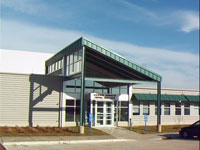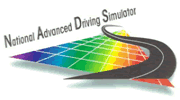 | The National Advanced Driving Simulator (NADS) is a research tool that will be used to conduct fundamental research into the operation of the complex driver-vehicle-environment system. Of the three elements of this system, the driver is unique as the single element that is non-deterministic, i.e., driver behavior defies description or prediction by means of common physical laws.As a consequence, the only practical means of studying driver behavior is by means of direct observation. The most valid method of conducting such research is to make observations while the driver is engaged in the actual driving task, in a real vehicle, operating on a real highway. | | However, many such experiments cannot be conducted without exposing the driver to unacceptable physical danger. Under these restrictions, the study of driver response during critical crash avoidance situations becomes a practical impossibility. | | The NADS will offer the capability to study driver crash avoidance behavior and carry out related accident reconstructions. The complete control of highway environment and traffic scenarios provided by the NADS will allow researchers to set up hazardous situations and measure driver response. This same experimental control capability will allow conditions to be set up associated with real accident cases, so as to study the response options and limitations of drivers and involved vehicles. |  | The NADS provides the capability for safely evaluating advanced vehicle communication, navigation, and control technologies which are now being developed as part of the Intelligent Transportation System (ITS) program. | | Important questions regarding the effect of these systems on driver workload, attention, behavior, and overall safety need to be addressed during the development phase. It is imperative to determine beforehand whether any of these advanced systems will have an unintended or detrimental impact on driver performance or highway safety. | | The NADS provides the means by which such experimental data can be generated. A clear understanding of driver behavior under these circumstances will lead the way to developing effective strategies and countermeasures for improved crash avoidance and reduced injuries and fatalities. | | The NADS also will provide a powerful and cost effective tool for conducting highway engineering and design research related to traffic safety. Since the driving scene and highway geometry are under the complete control of the simulator programmer, highway researchers will be able to evaluate alternative designs for intersections, entrances and exits, tunnel and bridge alignments, traffic control devices and highway signing without incurring the prohibitive expense of actual construction. |  | The NADS will be dedicated primarily to advancing the cause of improved highway safety and efficiency. As a national research facility, the simulator is accessible to the widest possible spectrum of researchers from both the public and private sectors. The Department of Transportation has located the NADS at the University of Iowa, who will be responsible for the daily operational research, maintenance, and long term upgrading of the NADS. | | |







